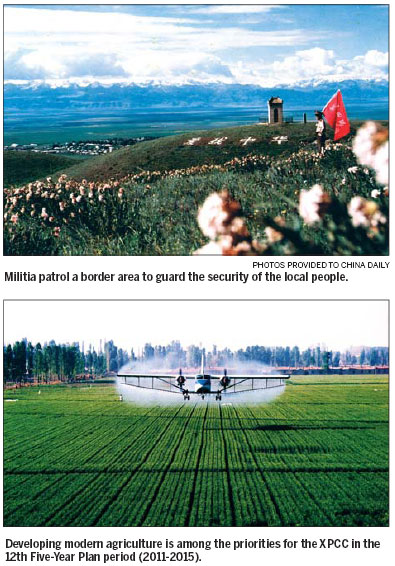Inclusive development helps safeguard borders

|
Bird's eye view of the city of Shihezi. |
The XPCC performs two duties entrusted by the Central government since its establishment in 1954: farm reclamation and guarding China's frontiers.
After the Central government unveiled its ambitious support package to Xinjiang in May 2010, the XPCC has quickened the process of urbanization in order to better protect the borders.
Through continuous urbanization efforts, people's livelihoods have greatly improved.
The incomes of city dwellers, farmers and herdsmen has increased, with the disposable incomes of urban residents reaching 13,000 yuan ($2,002) per capita in 2010, an increase of 8.7 percent year-on-year.
The per capita incomes of farmers and herdsmen reached 7,300 yuan, up 11.1 percent.
Working for well-being
XPCC has a long history in reclaiming land and working for the well-being of the people of all ethnic groups in Xinjiang.
In frontier areas it has established a "four-in-one" system of joint defense that links the People's Liberation Army (PLA), the Armed Police, the XPCC and the ordinary people, to resist and combat internal and external separatists' attempts at sabotage and infiltration, to ensure the stability and safety of the border.
In the 1950s, in accordance with a principle of "competing for no benefits with the local people", more than 100,000 soldiers of the XPCC built water conservancy works and reclaimed wasteland along the north and south edges of the Tianshan Mountains and along the borders.
In the 1960s when tensions increased along the borders, thousands of XPCC people were dispatched from the central part of the region to work and live in the border areas, patrolling the more than 2,000-kilometer border while also farming and herding.
Beginning with the processing of agricultural and sideline products, the XPCC developed modern industry and gradually formed a multi-sector industrial system. By the end of 1966, all its undertakings had developed to a high level.
Since the late 1980s, terrorism, separatism and extremism have sought to destabilize Xinjiang. The XPCC has played a significant role in cracking down on a series of violent crimes and terrorist activities and safeguarding the region's security and stability.
In 1989, when the "May 19 Unrest" happened in the region's capital Urumqi, the XPCC organized militia riot squads for the first time to protect the city's security.
On Feb 5, 1997, the XPCC dispatched its militias to successfully crack down on the ethnic riots in Ining, the Ili Kazak autonomous prefecture, Xinjiang.
After the July 5 Unrest in 2009 in Urumqi, which left at least 197 people dead and more than 1,700 injured, the XPCC recalled the militias scattered in different parts of the region to the city to safeguard the local people.
In addition, the XPCC has also been praised for its quick response to natural disasters, for example, the earthquakes in Bachu and Jiashi counties in south Xinjiang in 2003.
The next five years will be another period of rapid development for the XPCC, especially in strengthening its militias and public security force, say the XPCC authorities.
(China Daily 06/01/2011 page35)















